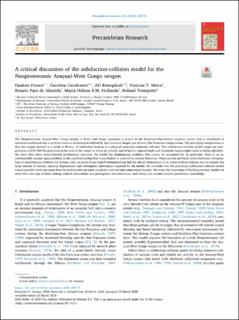| dc.contributor.author | Fossen, Haakon | |
| dc.contributor.author | Cavalcante, Carolina | |
| dc.contributor.author | Konopásek, Jiří | |
| dc.contributor.author | Meira, Vinicius T. | |
| dc.contributor.author | Trompette, Roland | |
| dc.contributor.author | Hollanda, Maria Helena B.M. | |
| dc.contributor.author | Paes de Almeida, Renato | |
| dc.date.accessioned | 2021-03-05T12:30:53Z | |
| dc.date.available | 2021-03-05T12:30:53Z | |
| dc.date.created | 2020-04-01T23:59:44Z | |
| dc.date.issued | 2020 | |
| dc.identifier.issn | 0301-9268 | |
| dc.identifier.uri | https://hdl.handle.net/11250/2731868 | |
| dc.description.abstract | The Neoproterozoic Araçuaí-West Congo orogen in Brazil and Congo represents a branch of the Brasiliano/Pan-African orogenic system that is considered to terminate northward into a confined cratonic environment defined by the horseshoe-shaped pre-Atlantic São Francisco-Congo craton. The prevailing interpretation is that this orogen formed as a result of 50 m.y. of subduction leading to a classical continent–continent collision. This subduction-collision model hinges on interpretation of 630–580 Ma granitoids in the core of the orogen as being arc-related, and of locally exposed mafic and ultramafic metamorphic rocks as being ophiolitic. We show that when tested beyond geochemical signature, the model has fundamental problems that cannot be accounted for. In particular, there is an insurmountable oceanic space problem in this confined setting that is overlooked in most of the current literature. There are also problems with subduction initiation, lack of unambiguous evidence for oceanic crust, no trace of any high-P metamorphism and the abrupt termination of an ocean with no realistic way to transfer the large amount of oceanic opening displacement and subsequent convergence required by the model. We conclude that the prevailing subduction-collision model cannot possibly work and argue that the existing data are more consistent with hot intracontinental orogeny. We stress the importance of building tectonic models on more than one type of data, making realistic restorations and palinspastic reconstructions, and taking into account modern geotectonic knowledge. | en_US |
| dc.language.iso | eng | en_US |
| dc.publisher | Elsevier | en_US |
| dc.rights | Navngivelse 4.0 Internasjonal | * |
| dc.rights.uri | http://creativecommons.org/licenses/by/4.0/deed.no | * |
| dc.title | A critical discussion of the subduction-collision model for the Neoproterozoic Araçuaí-West Congo orogen | en_US |
| dc.type | Journal article | en_US |
| dc.type | Peer reviewed | en_US |
| dc.description.version | publishedVersion | en_US |
| dc.rights.holder | Copyright 2020 The Authors. | en_US |
| dc.source.articlenumber | 105715 | en_US |
| cristin.ispublished | true | |
| cristin.fulltext | original | |
| cristin.qualitycode | 2 | |
| dc.identifier.doi | 10.1016/j.precamres.2020.105715 | |
| dc.identifier.cristin | 1804885 | |
| dc.source.journal | Precambrian Research | en_US |
| dc.source.40 | 343 | |
| dc.identifier.citation | Precambrian Research. 2020, 343, 105715. | en_US |
| dc.source.volume | 343 | en_US |

